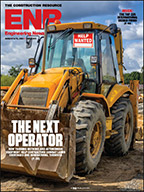Some rental companies will go to great lengths to keep clients. Ahern Rentals, for instance, the nation's largest independent rental company, opened a satellite maintenance shop in the high Nevada desert. It services a remote $900-million solar project under construction on federal land along the Crescent Dunes, about 226 miles northwest of Las Vegas. Setting up the shop provided service certainty and helped clinch a rental deal.
But rentals aren't always an option, especially for some specialty equipment.
"An asphalt paver is very difficult to rent. It's something that rental companies don't typically carry," says Mike Wills, a construction manager for Watsonville, Calif.-based Granite Construction Co., ranked the 242nd-largest private U.S. fleet owner for 2011 by Fleet Owner magazine. "You pretty much have to make a commitment to buy."
Granite can shuttle equipment between multiple offices across nine states as work arises, thereby avoiding low utilization time. Kiewit Corp.—Fleet Owner's 19th-largest private equipment owner last year—employs a similar strategy, moving machines where needed. For the Omaha, Neb.-based contractor, ownership allows greater control over availability.
Yet, purchasing a piece of machinery is a big decision. McCarthy, for example, looks at equipment use over a 10-year span with an expected 70% annual utilization rate before buying a piece of machinery. Other contractors take advantage of dealer rent-to-own programs, which offer the best of both worlds and help skirt sales commissions. But such programs aren't commonplace among rental companies, say industry observers, and dealers typically offer rent-to-own only for their best customers.
"If we do rent something, it's typically on a rental-purchase agreement that gives us a chance to try it out first," says Ewing, who believes fleet ownership offers his firm a competitive advantage. "Each piece of equipment has a cost to it when bidding a job. You begin to know those costs over the years."
Some of the costs include meeting new Tier IV federal emissions standards that add "10% to 15% in costs over earlier model year counterparts," says Sexson. And the expense is more acute in California, which has stringent off-road diesel-emissions standards.
"Everyone is working at a whole different level here," says Frank Scaduto, regional manager for ECCO Equipment's central and northern California branches. "Contractors are bidding with rental equipment because they sold their machines during the downturn."
In 2010, the California Air Resources Board required reduced nitrogen oxide and particulate matter emissions from existing off–road diesel equipment. The agency additionally required the retirement, retrofit, re-power or replacement of noncompliant equipment. CARB put that cost at $3.4 billion. The Associated General Contractors of America—which has twice appealed the ruling—pegs the cost at around $13 billion.
"We spent millions meeting the deadline, and there hasn't been any enforcement," Scaduto says. "We could lose a job to someone with a 20-year-old machine bellowing black [smoke] as a result. Everyone is battling over price. It's still a tough, fragile market."





Post a comment to this article
Report Abusive Comment